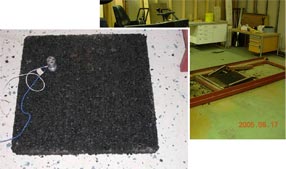SP3: Vehicle/infrastructure interface
Considerations
Subproject 3 is focussed on addressing the noise problem caused at the vehicle/infrastructure interface (wheel/rail and tyre/road).
For rail transport systems we start with a state of the art system and investigate the effects on noise for a number of fundamental variables that affect the wheel/rail interface: quality, geometry, and material properties. We will also study the indirect effects from the rail infrastructure: rail fastening systems, track subbase, special trackwork, and track layout, as well as special issues such as wheel squeal and corrugation.
On the road site, we also start with a state of the art tyre/road system and the effect of potential measures such as optimisation of the thread pattern, near field shielding, porous and wave bearing road surfaces. Indeed, it is the roughness of the road surface that is responsible for exciting the tyre. Since it is not realistic to expect smooth roads in the urban environment, road surface solutions will have to come from sound absorbing roads that are created by poroelastic road surfaces.
Based on the rankings of the above discussed technologies, a selection will be made that will be validated in various cities, and their performance will be measured (SP5).

Workpackage 1: Quantification of effect of contributing parameters to wheel/rail noise
- Definition of a reference system for tram, surface metro & freight train to compare against in quantification analyses
- Evaluation of effect of wheel & rail quality
- Evaluation of effect of wheel & rail geometry (New shapes – profile grinding, …)
- Evaluation of effect of material properties (hardness, steel type, …)
- Evaluation of effect of rail fastening system (discrete, continuous, …)s
- Evaluation of effect of track system (Surface – sub-base) (ballast, concrete, road surface type)
- Evaluation of effect of contributing parameters to wheel/rail noise in special trackwork
- Evaluation of effect of track lay-out (e.g. curves) on wheel/rail noise, including effects such as squeal/corrugation.
Workpackage 2: Quantification of effect of mitigation measures for wheel/rail noise
- Mitigation measures for wheels such as dampers, resilient wheels, wheel turning, …
- Mitigation measures for rail such as: Fastening system – grinding – rail dampers – special trackwork treatment – geometrical changes - special rail designs such as rail with increased web thickness – saddle profile rail – full profile rail.
- Ranking of mitigation measures and contributing parameters considering performance/costs/ general applicability/general acceptance. Most of the work to be carried out in this WP will be based on existing technology and available studies.
Workpackage 3: Quantification of noise emission of existing different tyres and road surfaces
- Develop and build a new suitable trailer for CPX measurements of tyre/road noise from passenger car tyres. Definition of a reference testing system for tyre/road interaction to compare against in quantification analysis.
- Measure noise emission from 10-15 currently used passenger car tyres and 5-8 types of truck tyres using CPX, drum and pass-by techniques.
- Evaluation of effect of road surface. Perform measurements of typical source heights for modern passenger car tyres. Evaluation of effect of tread design. Perform measurements of noise generation from road joints, road markings and rail crossings for 4-5 different tyre brands. Evaluation of effect of tyre geometry.
Workpackage 4: Parametric studies of tires and road parameters
Try to understand the physics of certain parameter changes that earlier have proven to result in noise reduction but never been fully understood. Examples of such parameter changes are:
- filling tyres with solid polyurethan rubber instead of air
- changing the tyre gross dimensions from wide and low to high and narrow (10 dB reductions have been found)
- mobility measurements near the contact edges, modal analysis, wave number decomposition, contact pressure distribution measurements, ... will be used in order to find the mechanisms of the found noise reductions.
The gained knowledge on what underlying parameters that governs the reduced sound emission will be used in an attempt to apply them in order to quiet current tyre constructions.
Workpackage 5: Refine & optimise the road surface
- In previous projects it has been found that road surfaces which are poroelastic (i.e. both display permeable communicating pores in the surface and substantially increased elasticity) can be very quiet (12-14 dB).
- Problems with wear still have to be tackled. A new technique for pre-coating the rubber with bitumen has though shown promising characteristics.
- Other means for creating poroelastic road surface characteristics will also be tested such as using a twin layer technique where the upper layer is made as a rather conventional open graded asphalt mix, while the lower layer is designed to display a high compliance.
- Another challenge is to achieve acceptable wear characteristics with as small stone sizes in the mix as possible. It has e.g. been found that 5-mm typical max. stone size will give 2-4 dB units more noise reduction as compared to a mix with 8-mm typical max. stone size